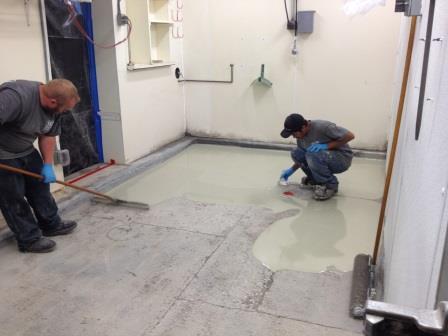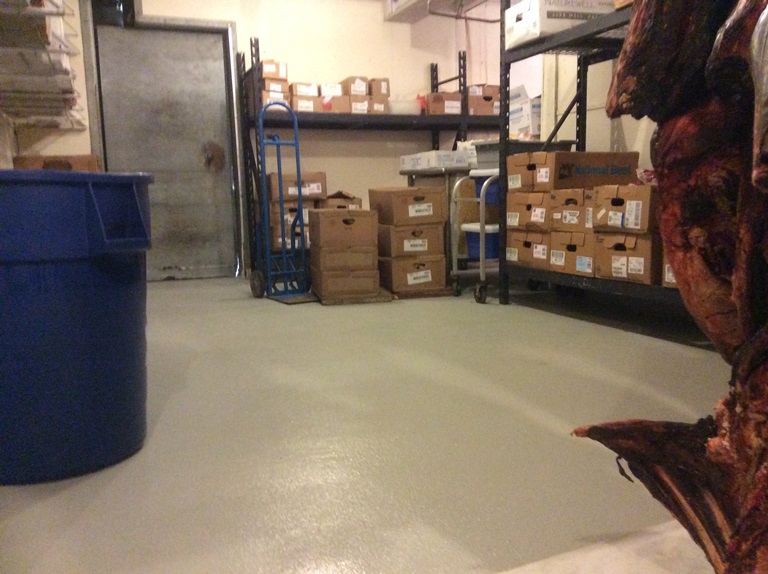You know how things can get in the kitchen when you’re preparing your meaty dinner? Things get a bit greasy and messy. Now imagine that but on a much larger scale and imagine that it's happening regularly in your kitchen for about 60 years.
For a local butcher shop in Northern California that wishes to remain unnamed, that is exactly what was happening. The business, which works with hunters to prepare various meats, was successful. And in the butchery business that means dealing with various animal fats and constant cleanup. “They do quite a bit of elk, deer, and pigs. That’s where people like to take their stuff ‘cause they do a good job,” explained Terry Keener Jr., owner of TNT Resurfacing Concrete, Inc. This was a floor that needed a makeover and Keener and his crew were the ones to do it.
Swap Meat
The building was undergoing a bit of a remodel and that included a rehab and some new coatings for their facility’s floor. “It was pretty rough,” Keener said of the floor’s original condition.
“The whole cap of the concrete was falling apart,” Keener said. “The top layer was deteriorating. It was the amount of water, years of wear and tear, and probably…concrete that had been worked on for 60 or 70 years.” While the general contractor (GC), which has worked with TNT over the years, worked on updating the facility, TNT focused on the floor. “It’s old — nowhere near new — and that’s what we had to work with. They were having a hard time cleaning, keeping all of the bacteria out. That’s when we came in to spec out a product that would work with their process.”
 According to Keener, the building hadn’t been updated in 20 or 30 years. That meant that once the GC set up what Keener referred to as a tent inside the building to contain the construction zone, the GC headed off to work on fixing pipes and electrical issues among other things.
According to Keener, the building hadn’t been updated in 20 or 30 years. That meant that once the GC set up what Keener referred to as a tent inside the building to contain the construction zone, the GC headed off to work on fixing pipes and electrical issues among other things.
Because the facility needed to stay open during the construction, the three-person coatings crew worked on the floor in two phases. The butchery operations moved onto one half of the floor, so that the crew could work on the other half. When the crew was finished with the first half, they swapped with the employees so that they could finish the second half of the floor. And since each half took two days to complete, the entire 2,000-square-foot (185.8 m²) job was done in four days.
System for Sweat
To start, the crew used a scarifier from Equipment Development Company, Inc. (EDCO) and a diamond grinder from HTC to prep what Kenner called the “terrible deteriorated slab.” Wearing deerskin gloves, glasses, and dust masks, the crew worked to remove that top cap of concrete. Then, after sweeping and vacuuming up the dust and debris, they were ready to apply the urethane cement.
The crew mixed up Westcoat’s self-leveling Temper-Crete, poured it onto the floor, and raked and squeegeed it. They backrolled it with a porcupine roller and then immediately broadcast 16 mesh sand into the wet urethane cement to the point of refusal. The Temper-Crete gave the concrete a new lease on life and the sand gave the floor a much-needed anti-slip quality. “They work in wet conditions; it’s always wet in there — the fat from the animals and stuff like that,” Keener said. “That was the reason for the Temper-Crete because the wetness of everything in there; Temper-Crete can put up with water — and durability, of course.” They installed the gray cement and gray sand per the client’s choice, and then they topped that off with a layer of EC-100X polyurea — again gray.
 The crew applied the polyurea at 1 gallon (3.8 L) per 100 square feet (9.3 m²) using squeegees. They backrolled it and pulled it up the wall about six inches (15.2 cm) to cover the concrete stem wall. Because this was already a straight line, they didn’t need any pull tape. And because they didn’t need anti-skid on the walls, they didn’t worry about getting the broadcast on the vertical surface.
The crew applied the polyurea at 1 gallon (3.8 L) per 100 square feet (9.3 m²) using squeegees. They backrolled it and pulled it up the wall about six inches (15.2 cm) to cover the concrete stem wall. Because this was already a straight line, they didn’t need any pull tape. And because they didn’t need anti-skid on the walls, they didn’t worry about getting the broadcast on the vertical surface.
Although the crew didn’t encounter any weather-related issues (after all, according to Keener, their California weather is “pretty good all the time”), they did encounter moisture in a different capacity: a sweating wall.
“Next door was the freezer, and they shut down the air conditioning in the one room we were doing so the walls started sweating…” Keener said. The crew had tried to soak up the water using rags, but the water would just drip down onto the newly poured floor. That is not a recipe for success. So the coatings rep from Westcoat, Michael Mulnix, who was on the jobsite every day to “watch the process go down,” as Keener explained, came up with a unique solution: They stuck feminine personal care products on the bottom of the walls to catch the water dripping down.
“We had to improvise on the fly,” said Mulnix. He admitted that it’s an “unusual approach,” but it worked and that’s what mattered!
Day by Day
Working with a familiar GC and a pleasant client made this job a positive one for Keener and his crew. “They were easy customers, which is very odd and hard to find,” explained Keener. “They’re just good people.”
And the project? “Real simple — real simple project,” Keener stated. Mulnix agreed. “The project went quick and seamlessly with a happy client,” he said.
It was up to the GC to tear the plastic down when the job was done, so once the polyurea had dried for six hours, all that was left for the TNT coatings crew was to pack up and head out. “That’s what we do every day,” Kenner said. This is one crew getting the job done one day at a time.
